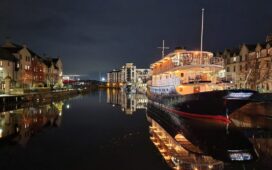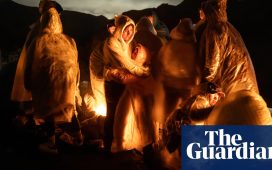
The James Webb Space Telescope (JWST) has captured a stunning mosaic image of the Tarantula Nebula that stretches 240 light-years across and includes tens of thousands of never-before-seen young stars that were not visible with previous telescopes.
The image above was captured with the JWST’s Near-Infrared Camera (NIRCam) and shows a massive star-forming region of space, captured as a mosaic of multiple photos and combined into a huge 122.5-megapixel photo (14,557 by 8,418 pixels). The most active region of star formation can be seen in the center of the photo, where the bright blue stars are most condensed.
The Webb Team explains that scattered among those blue stars are still-embedded stars which appear red and are yet to emerge from what they describe as a “dusty cocoon” of the nebula.
“NIRCam is able to detect these dust-enshrouded stars thanks to its unprecedented resolution at near-infrared wavelengths,” the Webb team says.
“To the upper left of the cluster of young stars, and the top of the nebula’s cavity, an older star prominently displays NIRCam’s distinctive eight diffraction spikes, an artifact of the telescope’s structure. Following the top central spike of this star upward, it almost points to a distinctive bubble in the cloud. Young stars still surrounded by dusty material are blowing this bubble, beginning to carve out their own cavity,” the Webb team continues.
“Astronomers used two of Webb’s spectrographs to take a closer look at this region and determine the chemical makeup of the star and its surrounding gas. This spectral information will tell astronomers about the age of the nebula and how many generations of star birth it has seen.”
This nebula was also shot with the Mid-Infrared (MIRI) camera, which focuses its view on the area surrounding the central star cluster.

“In this light, the young hot stars of the cluster fade in brilliance, and glowing gas and dust come forward. Abundant hydrocarbons light up the surfaces of the dust clouds, shown in blue and purple. Much of the nebula takes on a more ghostly, diffuse appearance because mid-infrared light is able to show more of what is happening deeper inside the clouds. Still-embedded protostars pop into view within their dusty cocoons, including a bright group at the very top edge of the image, left of center,” the Webb team says.
“Other areas appear dark, like in the lower-right corner of the image. This indicates the densest areas of dust in the nebula, that even mid-infrared wavelengths cannot penetrate. These could be the sites of future, or current, star formation.”
One of the reasons that astronomers are interested in the Tarantula Nebula is that it has a similar type of chemical composition as the gigantic star-forming regions that existed when the Universe was only a few billion years old and star formation was its highest. Thanks to Webb, astronomers can compare the observations from the Tarantula Nebula to other observations of distant galaxies that were also active during that time of peak star formation.
Image credits: NASA, ESA, CSA, STScI














